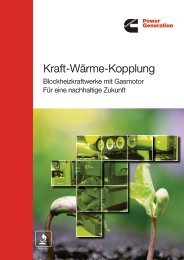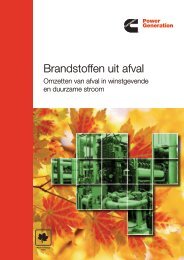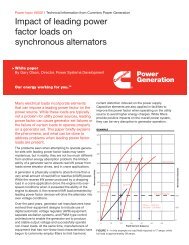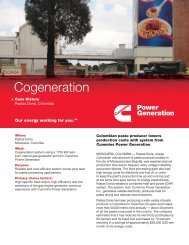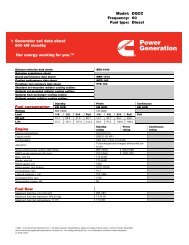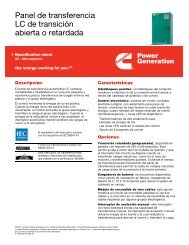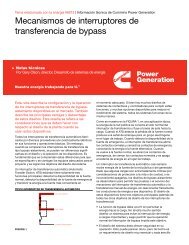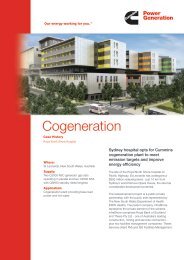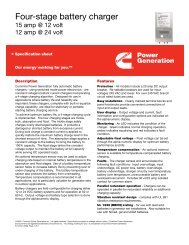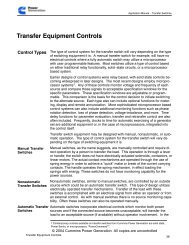appendix
appendix
appendix
Create successful ePaper yourself
Turn your PDF publications into a flip-book with our unique Google optimized e-Paper software.
Application Manual -- Liquid Cooled Generator Sets<br />
APPENDIX H<br />
List of Figures<br />
Figure 2--1. Typical One-Line Diagram of an Electrical Distribution System ..... 2--5<br />
Figure 2--2. Standby Power Rating. ....................................... 2--7<br />
Figure 2--3. Unlimited Running Time Prime Power .......................... 2--7<br />
Figure 2--4. Limited Running Time Prime Power ............................ 2--8<br />
Figure 2--5. Base Load Power ............................................ 2--8<br />
Figure 3--1. Voltage Dip in Medical Imaging Applications ..................... 3--13<br />
Figure 4--1. Four-Pole Generator Cross Section ............................ 4--5<br />
Figure 4--2. Self-Excited Generator ....................................... 4--6<br />
Figure 4--3. Separately-Excited (PMG) Generator ........................... 4--6<br />
Figure 4--4. Typical Voltage Profile on Load Application and Removal .......... 4--7<br />
Figure 4--5. Typical Generator Saturation Curves ........................... 4--8<br />
Figure 4--6. Excitation System Response Characteristics .................... 4--8<br />
Figure 4--7. Transient Voltage Dip ........................................ 4--10<br />
Figure 4--8. Typical Across-the-Line Motor Starting Characteristics<br />
(Assumes 100% of Nominal Voltage at Motor Terminals) .......... 4--11<br />
Figure 4--9. Sustained Voltage Dip ........................................ 4--12<br />
Figure 4--10. Typical NEMA Generator Chart of Transient Voltage Dip vs. Motor<br />
Starting KVA ................................................ 4--12<br />
Figure 4--11. Symmetrical Three-Phase Short Circuit Response ............... 4--13<br />
Figure 4--12. Short Circuit Capability ....................................... 4--13<br />
Figure 4--13. Approximate Short Circuit Winding Temperatures ................ 4--14<br />
Figure 4--14. Typical Electric Starter Motor Connections (24 Volt System<br />
Shown) ..................................................... 4--16<br />
Figure 4--15. Resistance vs. Length for Various AWG Cable Sizes ............. 4--17<br />
Figure 4--16. Typical Piping Arrangement for an Air Starter .................... 4--18<br />
Figure 4--17. Two--Wire Control Interface Panel .............................. 4--19<br />
Figure 4--18. Detector 12t Control Interface<br />
Panel ...................................................... 4--19<br />
Figure 4--19. Power Command Microprocessor System ....................... 4--20<br />
Figure 4--20. Power Command Full Authority Electronic ..................... 4--20<br />
Figure 4--21. Water Jacket Heater Installation. Note Heater Isolation Valve,<br />
Hose Type, and Hose Routing. ................................ 4--27<br />
Figure 5--1. Generator Set Serving Common Loads ......................... 5--5<br />
Figure 5--2. Multiple Generator Sets Serving Common Loads ................. 5--6<br />
Figure 5--3. Single Generator Set Standby Applications ...................... 5--7<br />
Figure 5--4. Multiple Generator Sets, Multiple ATS Applications ............... 5--8<br />
Figure 5--5. Simple MV/HV Generator System For Prime Power .............. 5--9<br />
Figure 5--6. HV/MV Scheme For Multiple Generators / Utility Supplies<br />
And Loads .................................................. 5--10<br />
Figure 5--7. Low Voltage Generator For MV/HV Application .................. 5--11<br />
Figure 5--8. Parallel Generators .......................................... 5--17<br />
Figure 5--9. Sample HV/MV/LV Distribution System ......................... 5--22<br />
Figure 5--10. Typical Generator Set Control and Accessory Wiring ............. 5--25<br />
Figure 5--11. Feeder Ampacity ............................................ 5--26<br />
Figure 5--12. Allowable Unbalanced Single-Phase Load (Typical Three--Phase<br />
Generator From Cummins Power Generation) ................... 5--29<br />
Figure 5--13. Typical Steady State Alternator Reactive Power Capability<br />
Curve ...................................................... 5--31<br />
H--2 APPENDIX H<br />
Rev. Jan 2011



